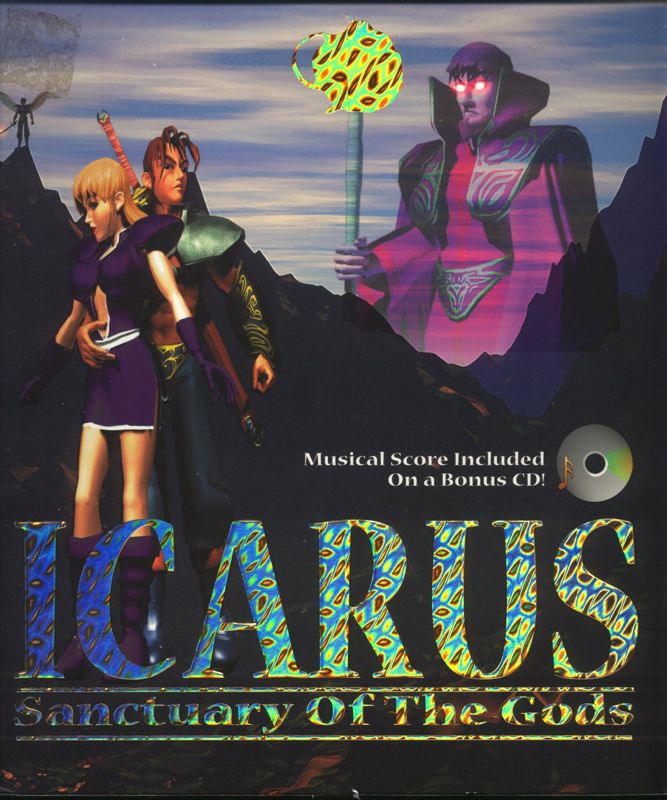Retro Replay Review
Gameplay
Icarus: Sanctuary of the Gods unfolds in classic turn-based fashion, placing your party of heroes on expansive battlefields where positioning and skill synergy matter. At the start, you control Dreus alone, learning basic attack and defense commands against corrupted beasts. As the game progresses, new party members join—each bringing unique abilities and elemental affinities that can be combined for devastating combos or defensive formations.
(HEY YOU!! We hope you enjoy! We try not to run ads. So basically, this is a very expensive hobby running this site. Please consider joining us for updates, forums, and more. Network w/ us to make some cash or friends while retro gaming, and you can win some free retro games for posting. Okay, carry on 👍)
Combat encounters balance straightforward enemy waves with occasional mini-bosses that require clever use of terrain or buff/debuff magic. The game’s menu-driven interface allows you to chain spells, heal allies, or unleash powerful “Divine Art” abilities inherited from Tetheus’s legacy. Character progression feels satisfying: as Dreus and Helena level up, their skill trees branch into multiple paths, letting you specialize in swordsmanship, support magic, or even limited summoning of minor spirits.
Outside of battle, exploration follows a mostly linear path, but hidden chests and optional side quests push you to revisit earlier regions. By completing these tasks, you unlock new equipment and accessories that give tangible boosts in combat. While the lack of a fully open world may disappoint completionists, the pacing keeps the narrative tight and prevents filler wandering that can bog down many JRPG-inspired titles.
Graphics
The visual style of Sanctuary of the Gods draws heavily from manga and anime aesthetics, with character portraits featuring expressive eyes, fluid hair animations, and vibrant color palettes. Overworld environments range from sun-dappled forests to eerie ruins tainted by Ercanet’s corruption, each area rendered in crisp HD detail. Environmental effects, like swirling mist or rain-soaked stones, add atmosphere without overtaxing mid-range hardware.
Battle animations stand out thanks to the “Divine Art” sequences—each deity-derived ability is accompanied by dynamic light flares, swirling glyphs, and camera zooms reminiscent of classic anime power-ups. Enemy designs are equally memorable, blending bestial forms with dark, corrupted runes that underscore the theme of souls twisted by Ercanet’s malice. Even minor skirmishes feel cinematic, thanks to seamless transitions from exploration to combat.
User interface elements are clean and unobtrusive: health bars, magic gauges, and action menus use a stylized typeface that complements the fantasy setting. Inventory screens are well-organized, with clear icons for weapons, armor, and consumables. Though load times pop up between major areas, they remain brief enough to keep immersion intact, ensuring that the game’s visuals rarely feel held back by technical hiccups.
Story
The narrative begins with a classic divine conflict: Tetheus, the benevolent god, has driven out the evil Ercanet, only for Ercanet’s lingering hatred to manifest through corrupted souls and nightmarish creatures. This mythic backdrop gives rise to Colias, Ercanet’s emissary, who reshapes the continent of Icarus into a land besieged by despair. Against this turmoil stand Dreus and his fiancée Helena, survivors of the failed Coshark mercenary resistance.
Storytelling in Sanctuary of the Gods is character-driven and linear. Each major chapter introduces new allies—such as a maverick archer from the eastern plains or a repentant former cultist—whose personal motivations dovetail with the central quest. Dialogue is well-written, peppered with light humor and heartfelt moments that reinforce the bonds within your party. Occasional flashbacks fill in the lore of Icarus, revealing Tetheus’s past deeds and Ercanet’s fall from grace.
While the main plot follows a predictable “good versus evil” arc, plot twists involving hidden loyalties and divine politics provide welcome complexity. Helena’s backstory, in particular, unfolds over several pivotal scenes, giving emotional weight to her struggle against Ercanet’s corruption. By the final act, the interplay between human determination and godly intervention feels earned, even if a few secondary characters could have used more development.
Overall Experience
Icarus: Sanctuary of the Gods delivers a polished RPG experience that blends familiar Japanese-style mechanics with a distinct Korean narrative sensibility. Its strengths lie in its tight pacing, memorable combat animations, and a story that, while linear, offers enough character moments to keep you invested. Newcomers to turn-based RPGs will appreciate the clear tutorials and gradual difficulty curve, while series veterans will enjoy the depth found in late-game boss fights.
Technical performance is stable across a variety of systems, with only minor frame drops in some of the most graphically intense Divine Art sequences. The soundtrack complements both high-stakes battles and quieter exploration segments, marrying orchestral sweeps with traditional Asian instrumentation. Voice acting is limited but effective, giving key moments the emotional resonance they need without dragging down the pace.
Overall, Sanctuary of the Gods stands as a compelling choice for fans of story-driven RPGs. Its blend of engaging turn-based combat, rich anime-inspired visuals, and a heartfelt quest to restore peace makes it a title worth exploring. Whether you’re drawn to the drama of godly conflicts or simply seeking a well-crafted journey with lovable characters, Icarus offers a sanctuary of adventure that’s hard to resist.
 Retro Replay Retro Replay gaming reviews, news, emulation, geek stuff and more!
Retro Replay Retro Replay gaming reviews, news, emulation, geek stuff and more!




Reviews
There are no reviews yet.